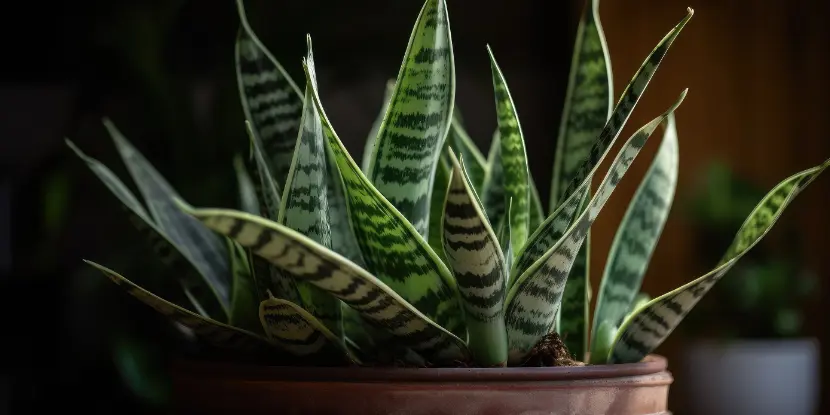“It takes a licking and keeps on ticking.” Timex adopted this slogan for wristwatches in the ’60s.
Snake plants don’t have a slogan, but they should. They’re almost indestructible.
The snake plant is tailor-made for forgetful gardeners and busy folks who may miss a watering or two. Its sleek, clean lines, unusual foliage, and tolerance for low light conditions make it a favorite indoor plant.

Dracaena trifasciata, or mother-in-law’s tongue, is the most popular snake plant variety.
Why Is the Snake Plant So Special?
Snake plants are native to West Africa. Their distinctive, spearlike leaves grow from a central crown and fan out upright.
The plant is a natural air purifier par excellence. A 1989 NASA study found that snake plants can remove toxins like formaldehyde and benzene from indoor air, and continue to convert CO2 into oxygen at night.
Other benefits include:
- Low Maintenance: Snake plants are incredibly forgiving of inattention and neglect (but please don’t neglect your snake plant!).
- Versatile Aesthetics: With their striking, almost sculptural vertical leaves, snake plants add a contemporary touch to decor, from minimalist to boho chic.
- Durability: These perennials thrive in various lighting conditions and are pest-resistant. A well-tended snake plant can live for well over a decade.

Dracaena angolensis, or African Spear, growing in a nursery plate.
Choosing the Right Snake Plant
There are over 120 species of Dracaena, formerly including the Sansevieria genus, each with unique characteristics. Popular options include:
- Dracaena trifasciata (formerly Sansevieria trifasciata), also known as mother-in-law’s tongue or viper’s bowstring hemp, has tall, broad leaves with green-gray stripes on the edges.
- Dracaena angolensis (formerly Sansevieria cylindrica), commonly called the African spear plant, features round, upright leaves that can grow up to several feet tall. It’s especially well-suited for contemporary interiors.
- Dracaena trifasciata ‘Laurentii’ (formerly Sansevieria trifasciata ‘Laurentii’) is a hardy variant with striking yellow-green leaf margins. It offers a bit more visual appeal than most other snake plants.
- Dracaena ‘Moonshine’ (formerly Sansevieria moonshine) boasts silvery-green leaves contrasting with its darker counterparts. Its subtle color palette makes it an excellent choice for a modern interior.
- Dracaena masoniana (formerly Sansevieria masoniana), also called the whale fin snake plant, is identifiable by its broad, paddle-shaped leaves. It can serve as an eye-catching focal point in your plant collection.

Dracaena masoniana, also called the whale fin snake plant, is identifiable by its broad, paddle-shaped leaves.
Basic Snake Plant Care
Caring for snake plants is a breeze once you understand their basic needs. They’ll survive some neglect, but in the right conditions, they can live for more than 20 years. The oldest reported snake plant is approximately 80 years old! Plus, a single plant can be propagated into multiple new plants, achieving a sort of immortality.
Light
- Snake plants prefer bright, indirect light. A spot near a window with filtered sunlight is ideal.
- They can tolerate low light conditions and will adapt to the darker corners of your home.
- Avoid placing them in prolonged direct sunlight, which can scorch their leaves.
Water
Overwatering is the number one killer of snake plants, so it’s crucial to get this right:
- Always allow the soil to dry out completely between waterings. Snake plants are drought-tolerant and prefer being too dry rather than too wet.
- During the growing season (spring and summer), water every 2–4 weeks. In the dormant season (fall and winter), reduce watering to once a month or less.
- Ensure your pot has good drainage, and never let your plant sit in standing water.

Dracaena Moonshine’s subtle color palette makes it an excellent choice for a modern interior.
Soil & Potting
- Use a well-draining cactus or succulent mix, or add perlite or sand to standard potting soil to improve drainage.
- Choose a pot that’s not too large. Snake plants prefer being a bit root-bound, so repot when roots burst out of the pot.
Temperature & Humidity
- Snake plants prefer temperatures between 60°F and 75°F (15°C to 24°C). Avoid exposing them to temperatures below 50°F (10°C).
- They thrive in the low humidity of most households.
Fertilizing
- Fertilize sparingly with a balanced houseplant fertilizer once every 2–3 months during the growing season.
- Too much fertilizer can cause leaf burn and other issues, so always follow the instructions on the fertilizer package.

Dracaena angolensis, also known as the cylindrical snake plant.
Propagating Snake Plants
Propagating snake plants allows you to expand your collection or share plants with others. Follow these steps for success:
- Select a healthy, mature leaf from the parent plant.
- Cut the leaf into sections about 4 to 6 inches long. Each section should have a clean edge.
- Allow the cuttings to dry in a warm, dry place for a day or two. This helps the cut ends callous over, reducing the risk of rot when planted.
- Use a well-draining soil mix, such as a cactus or succulent mix. You can also create your own by mixing potting soil with perlite or sand.
- Insert the calloused end of each leaf section into the soil, burying it about an inch deep.
- After planting, lightly water the soil to settle it around the cuttings. Avoid overwatering.
- Place the planted cuttings in a warm area with indirect light. Avoid direct sunlight until they establish roots.
- Be patient; roots may take a few weeks to develop. After a month, you can gently tug on the cuttings to check for resistance, which indicates root growth.

Snake plants are easy to propagate from cuttings.
Common Problems and How to Solve Them
Even though snake plants are tough cookies, they can run into problems. Here’s how to handle them:
Yellow Leaves
- Cause: Overwatering or poor drainage.
- Solution: Cut back on watering, ensure proper drainage, and remove yellowed leaves to prevent rot.
Brown Tips
- Cause: Low humidity or inconsistent watering.
- Solution: Increase humidity by misting the leaves or using a humidifier, and ensure a consistent watering schedule.
Pests
- Common culprits: Mealybugs and spider mites can occasionally attack snake plants.
- Solution: Wipe leaves with a damp cloth and use insecticidal soap or neem oil to treat infestations.
FAQs: Caring for Snake Plants
Q: Why is my snake plant not growing?
Growth can be slow if the plant isn’t getting enough light or it’s dormant. Place your plant in a bright spot and be patient.
Q: How can I tell if my snake plant is healthy?
Healthy snake plants have firm, upright, vibrant green leaves with distinctive patterns. Any drooping, yellowing, or mushy leaves can indicate an issue.
Q: Is the snake plant safe for pets?
Snake plants are mildly toxic if ingested, so it’s best to keep them out of reach of pets and children.
Q: How often should I repot my snake plant?
Snake plants usually need repotting every 2 to 3 years or when you notice roots growing out of the drainage holes. Repotting helps refresh the soil and provides more space for growth.
Q: Can I place my snake plant outside?
While snake plants can be grown outdoors in warm climates, they must be protected from direct sunlight and prolonged extreme temperatures. A shaded patio or balcony can be a good spot during the warmer months.
Q: What should I do if my snake plant has root rot?
Carefully remove the plant from its pot and trim away rotten roots with sterilized scissors. Replant in fresh, well-draining soil and avoid overwatering in the future.
Q: Are there any special considerations for growing snake plants indoors?
Ensure adequate indirect light and proper airflow. Keep plants away from drafty windows or heating vents.
Q: Can snake plants flower indoors?
Although rare, snake plants can produce flower spikes under optimal conditions. However, flowering is more common outdoors, and indoor plants may not bloom if kept in less-than-ideal light or care conditions.

